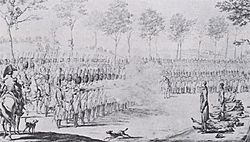Malet coup of 1812 facts for kids
The Malet coup of 1812 was a secret plan to take over the government in Paris, France. It aimed to remove Napoleon I from power. At the time, Napoleon was far away, leading his army in Russia.
The plan was made by a general named Claude François de Malet. He was a republican, meaning he believed France should be a republic, not an empire led by an emperor. Malet had been unfairly put in prison because he disagreed with Napoleon. The coup failed, and the main people involved were punished.
Contents
Why Malet Planned the Coup
Claude François de Malet was born in 1754. He was a brave soldier during the French Revolutionary Wars. Over time, he grew to dislike Napoleon Bonaparte. Malet did not agree with Napoleon becoming the First Consul, which was a very powerful leader.
By 1804, Malet was a general. He quit his job after Napoleon crowned himself Emperor of the French. Malet believed France should be a republic, not an empire.
Malet's Imprisonment
After quitting, Malet became a governor in places like Pavia and Rome. These cities were controlled by France. But Napoleon's stepson, Eugène de Beauharnais, accused Malet of plotting against Napoleon. Because of this, Malet was removed from his job and sent to prison in France.
In 1812, Malet was allowed to move to a special hospital called a sanatorium. His wife had asked for this.
Planning the Takeover
While at the sanatorium, Malet met people who wanted to bring back the old French kings. Even though he met with them, Malet mostly wanted France to be a republic again. He started planning to overthrow the emperor.
Napoleon was away fighting in Russia in 1812. This gave Malet a perfect chance to act. He and others made detailed plans to take control of the government. They planned to set up a temporary government after the coup.
The Coup Begins
Taking Control in Paris
On October 23, 1812, at 4 in the morning, Malet escaped from the sanatorium. He put on a general's uniform. He went to Colonel Gabriel Soulier, who led a group of soldiers called the 10th Cohort of the French National Guard.
Malet told Colonel Soulier that Napoleon had died in Russia. He showed Soulier some fake documents to make him believe it. Soulier was sick and surprised by a "promotion" that was also in the fake papers. He obeyed Malet and gathered his soldiers. Soulier did not question Malet, even when Malet said he would arrest important officials. The soldiers followed Soulier and went with Malet to La Force Prison.
Freeing Other Generals
At La Force Prison, Malet ordered the guards to release two generals who were prisoners there. Their names were Victor Lahorie and Maximilian-Joseph Guidal. The guards obeyed Malet. These generals, like Malet, were republicans. They agreed to join the coup.
Malet sent Lahorie to arrest the Duke of Rovigo, who was the Minister of Police. Guidal, with some National Guards, was supposed to arrest General Henri Clarke, the Minister of War. Guidal insisted on going with Lahorie to arrest Rovigo. The two generals woke Rovigo up and put him in La Force Prison. They did not arrest the other two officials.
Other important officials, like the police chief of Paris, Étienne-Denis Pasquier, were also arrested. Lahorie was given the job of Minister of General Police. While this was happening, Malet went to confront General Pierre-Augustin Hulin. Hulin was the commander of the Paris soldiers. Malet told Hulin that he was no longer in charge. He also demanded that Hulin give him an important seal. When Hulin asked to see official papers, Malet shot him in the jaw.
Stopping the Coup
Malet then went to the military headquarters. There, he met Colonel Pierre Doucet. Doucet was suspicious. The letters about Napoleon's death said he died on October 7. But Doucet knew that Napoleon had sent letters after that date. The colonel also recognized Malet as someone from the sanatorium.
When they were alone in the office, Doucet overpowered Malet and arrested him. Doucet then ordered the 10th Cohort of the National Guard to return to their barracks. He released Rovigo and other officials who had been imprisoned. He also told the Minister of War, Clarke, what had happened.
Clarke sent soldiers from the Imperial Guard to protect the Ministry of Police. He worked to bring order back to Paris. He also tried to make Rovigo look bad, saying he was not good at his job. Clarke told an important official named Cambacérès about the coup. He urged Cambacérès to take Empress Marie-Louise and Napoleon's young son, the King of Rome, to a safe place.
What Happened Next
Malet, Lahorie, and Guidal were put on trial by a military court. They were executed by a firing squad on October 29. Other people, including Colonel Soulier, who had been tricked into helping the coup, were shot on October 31. Colonel Jean François Rabbe, who commanded the Paris Guard and was also fooled, was not executed.
The 10th Cohort was sent away to a city called Bremen. Minister of War Clarke started to investigate all the generals in Paris on October 23. He removed any who he thought had supported Malet. Napoleon rushed back to Paris from Russia. He did not punish Rovigo, which disappointed Clarke. Napoleon had wondered why his ministers did not immediately declare his son, Napoleon II, as the new Emperor when they heard of his supposed death.


